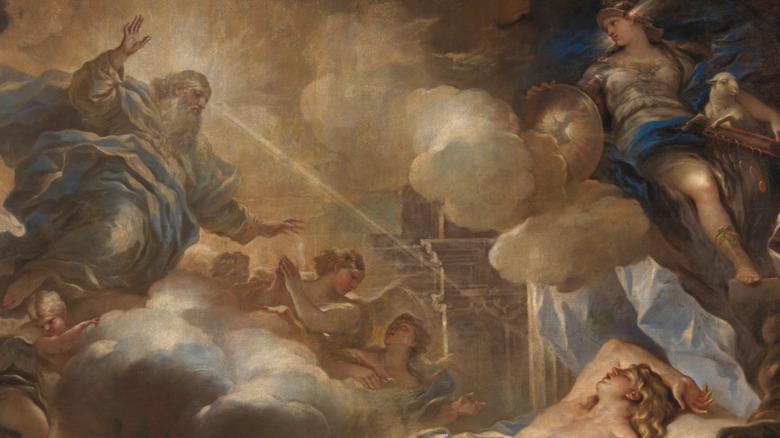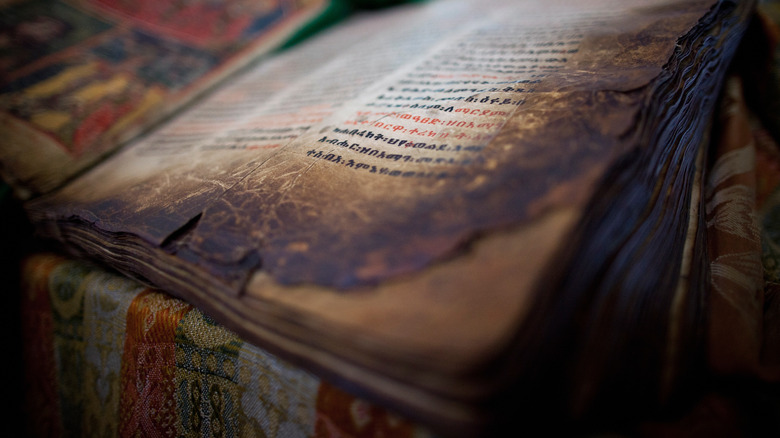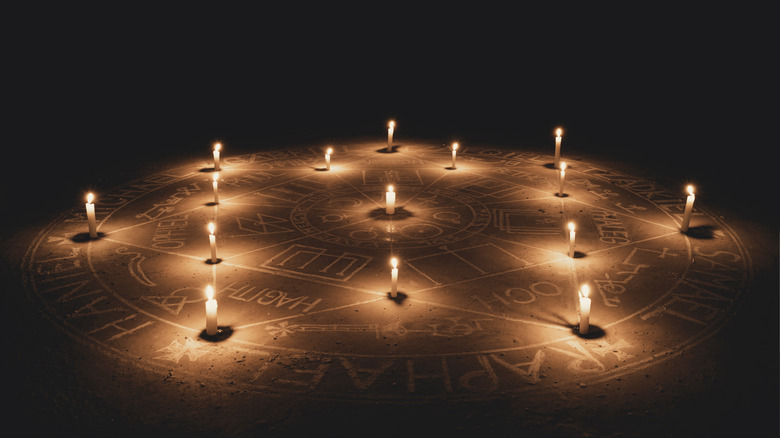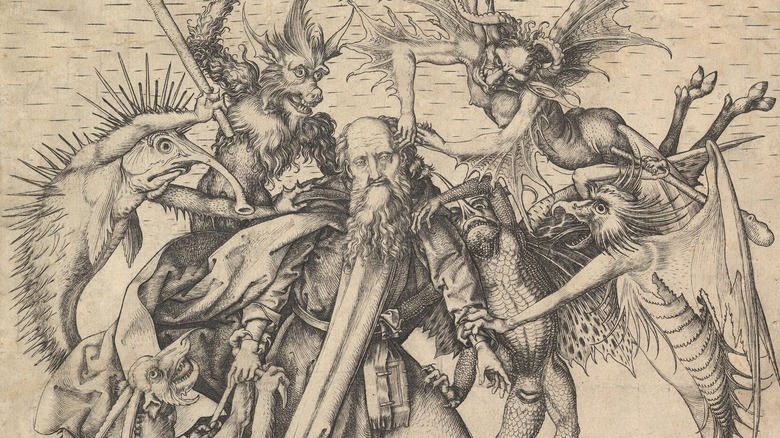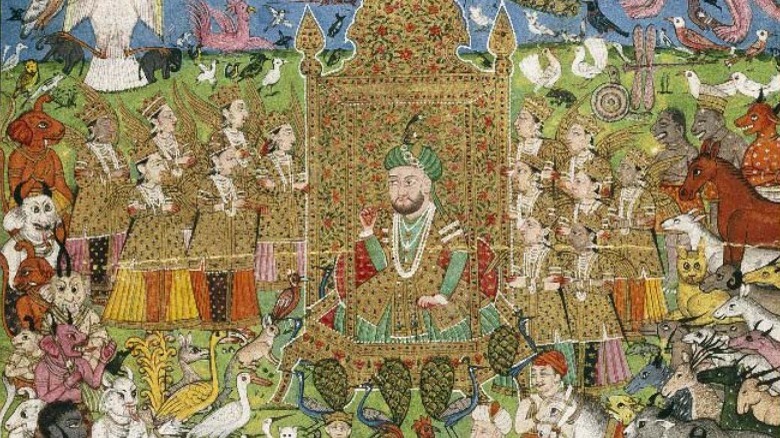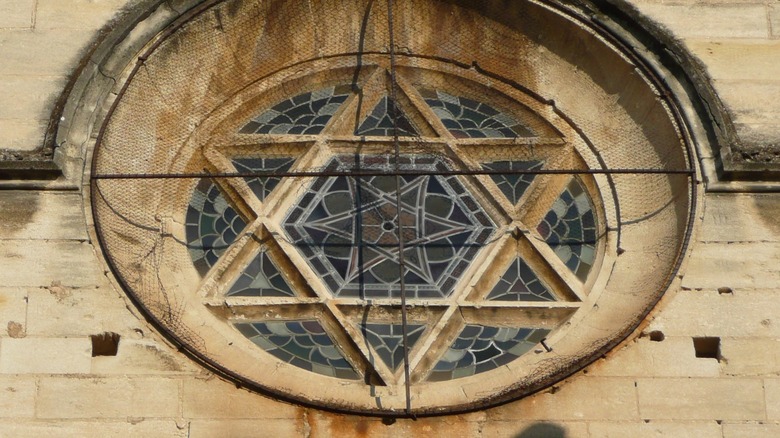The Truth About King Solomon's Magic Ring
Solomon (or Suleiman/Sulayman by the Arabic variant) is one of the Abrahamic religions' more standout figures. Folks familiar with the Hebrew and Christian Bibles may know him as the ultra-rich son of David/Dawud, the (potentially mythological) king who unified the ancient tribes of Israel. They might also know that he oversaw the building of the First Temple of Jerusalem around 1000 BCE, later destroyed by King Nebuchadnezzar of Babylon in 586 BCE.
Or, people might know him as Solomon the Wise (not to be confused with Saruman the White), whose quotes can be found in the Old Testament book of Proverbs. Biblical stories illustrate his wisdom, such as the one where he discovered which of two women was the true mother of an infant by bluffing — we assume — to cut the baby in two, found in 1 Kings 3:16-28. He is also often incorrectly credited with writing the erotic love poetry of the Old Testament's "Song of Solomon" (or "Song of Songs"), an error that would be easy to make, because even the Bible (1 Kings 11:1-3) says that he had 700 wives and 300 concubines.
The Qur'an, Rabbinic lore, and extrabiblical texts like the "Wisdom of Solomon" depict a very different version of Solomon, though: wielder of magic, subjugator of djinn, sitter on a throne of robot animals, and rider of a flying eagle who carried him to visit fallen angels chained to stone, Prometheus style. And he had a magic ring.
Ancient apocryphal texts of mysticism, magic, and heresy
Some of the more outré writings about Solomon, catalogued in the Jewish Encyclopedia, have been excluded from sanctioned versions of theological literature. Aggadah, the Apocrypha, the Pseudepigrapha, and various occult and mystical writings relate stories of demonic conversations, djinn, ritual magic, astrology, and spirit journeys.
Many of these tales are "gnostic" in nature, or connect to Kabbalah. Gnosticism is a 17th-century term applied to ancient, esoteric, non-canonical writings, fragments of texts, and entire lost books, like the Gospel of Judas, discovered in the 1970s, as PBS outlines. These writings often contradict longstanding theology or put different spins on traditional stories — for instance, Judas was secretly party to his betrayal of Jesus the whole time, or there is no "resurrection of the body" for Christians because heaven is non-corporeal. Kabbalah is a sub-section of these kinds of writings, written by 2nd-century Rabbi Simeon ben Yohai and republished by Rabbi Moses de Leon in the 13th century in "The Zohar," as the Jewish Virtual Library explains.
Solomon's magic ring story falls within these kinds of writings, particularly the "Testament of Solomon," a set of passages in the Pseudepigrapha — texts falsely attributed to certain authors — written somewhere between 300 BCE and 300 CE, per World History Encyclopedia. For the truly intrepid, you can find the "Testament of Solomon" starting on page 960 of the widely-regarded 1983 edition of "The Old Testament Pseudepigrapha" by Doubleday Publishing, readable on the distance learning platform eClass.
Infernal confessions, celestial conspiracies, and a demon sucking thumbs
The "Testament of Solomon" starts with (deep breath, people) a demon sucking the lifeforce, and half the salary, out of the right thumb of one of the children building Solomon's temple. It continues with Solomon receiving a magic ring from the archangel Gabriel, holding court with demonic entities like Asmodeus, prophetically learning of a vast celestial conspiracy, and eventually betraying God to have sex with a pretty lady. And if this whole "magic ring slash demon interviews slash celestial conspiracy slash god-betraying sex" story doesn't sound prime time enough, its details boggle the mind.
Per eClass, we've got: "the doglike demon, Scepter" sealed using an "emerald stone" and Solomon's ring; a "three-headed dragon spirit, Head of the Dragons" who "ascended at the 'Place of the Skull;'" "Enepsigos, the female demon with two heads" who has a "thwarting angel" Raphael, and whom Solomon seals with a "triple-link chain;" "Kunopegos, the cruel sea-horse demon" who gets sealed in a bowl; "thirty-six heavenly bodies, their heads like formless dogs," with names like Kairoxanondalon, Saphthorael, and Rhyx Axesbut; the beautiful "Onoskelis," who has mule legs and seduces "honey-colored" men because they are "of the same constellation;" "Lix Tetrax," who crawls like a snail and sets fields on fire; "Adarkes, king of Arabia," who recruits Solomon to fight the "wind spirit" Ephippas, and pages upon pages more.
Meanwhile, historians and scholars, as Biblical Studies chronicles, still debate whether or not Solomon even existed.
A kingly court stuffed with a diabolic menagerie
At the heart of the "Testament of Solomon," written in first person, is Solomon's magic ring. Solomon goes to the "Temple of God" and begs for a way to capture and control the demon who is stealing the vitality and salary of his child laborer. The archangel Gabriel shows up, forks over the ring, and voilà – Solomon's got that Captain Planet-type power.
Solomon gives the ring to the child laborer, who throws it at the chest of his thumb-sucking tormentor, Ornias, who then, on Solomon's command, throws it at the chest of the "Prince of Demons," Beelzeboul, and on and on it goes. Demon after demon comes to Solomon's court. Each demon reveals to Solomon the secrets of humanity-destroying prophecies while quivering before his might, and as punishment, each demon is forced to help build Solomon's temple through quarrying stone, cutting marble, spinning rope, that sort of thing. How? Solomon places the "seal" of his ring (more on the seal later) on each demon and more or less compels them to obey him.
There are honest-to-goodness magic words, as well as zodiac-based explanations for demonic powers such as "I strangle those who reside in Aquarius because their passion for women whose zodiacal sign is Virgo." There's even a reference to Zeus.
An 1899 article in the Guardian Church Newspaper said the story is "foolish," "superstitious," "futile," "interesting," "amusing," and "sometimes picturesque."
Magic rings couldn't quench Solomon's thirst
Before you declare this ring tale totally bats***, consider that a couple aspects of the story jive with both the Bible and the Qur'an.
Qur'an, 27:17 implies that Solomon had direct control over anything created by Allah, including animals and djinn, which before him were "perfectly organized" "in rows." Djinn, here, have nothing to do with genies, magic lamps, or superb Robin Williams voice acting. They're part of pan-Arabic folklore that persists to the modern day. Not quite "demons," in a Western sense, djinn are more closely related to the "daimons" in Plato's 385 BCE "Symposium" (readable on Project Gutenberg): non-human, non-divine intermediaries between humanity and the gods. Like the entities that Solomon summons and commands in the "Testament of Solomon," djinn sometimes interfere with humanity and attempt to wrangle the wayward into very un-pious ways of life.
And then we've got Solomon's downfall: his eye for the ladies. Remember those 1,000 combined wives and concubines? Well, in 1 Kings 11:1-3 in the Bible, Solomon invited foreign beliefs into his home through his harem. Eventually, he started appealing to his women's gods, and "followed Ashtoreth the goddess of the Sidonians, and Molek the detestable god of the Ammonites," which led to him turning away from the God of Israel.
This is exactly what happens in the magic ring story from the "Testament of Solomon," on pages 986-987 (per eClass).
Magic symbols and Freemasonry
So what exactly was on Solomon's ring, if anything? Inscriptions, engravings, some elvish script that appears when it's held over fire? The Israel Ministry of Foreign Affairs has an answer: the hexagram, a six-pointed star, otherwise known as the "Star of David" or the "Seal of Solomon." The symbol has been found on Middle Eastern architecture going back to the 3rd century CE, and was referenced all the way back to master mathematician Pythagoras (570-490 BCE) to symbolize the connection between heaven and Earth. (A hexagram is two triangles, one pointed up, the other down, as in the photo above.)
The Seal of Solomon has become adopted by numerous belief systems. The Zohar, holy book of modern-day Kabbalists, describes it: "There are three knots connecting [three entities] one to another: the Holy One, blessed be He; Torah; and Israel," per Chabad. For Muslims, as this thread on Quora discusses, the symbol's points relate to the prophets Adam, Noah, Abraham, Moses, Jesus and Mohammed. Freemasons also claim a connection to Solomon, his temple, and the ring-driven demons who built it. They state that the "mystic name of God" was found on a gold plate in an "underground vault" in the temple, which wound up in the hand of their order, per Érudit.
But hey, no reason we have to miss out on the magic ring fun. Just head over to Etsy and snag an imagineered version of it. Just don't try to command any infernal forces.
